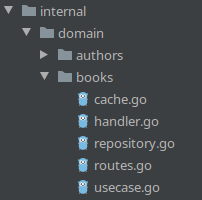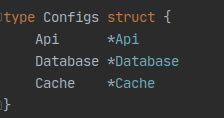.,*/(#####(/*,. .,*((###(/*.
.*(%%%%%%%%%%%%%%#/. .*#%%%%####%%%%#/.
./#%%%%#(/,,...,,***. ....... *#%%%#*. ,(%%%#/.
.(#%%%#/. .*(#%%%%%%%##/,. ,(%%%#* ,(%%%#*.
.*#%%%#/. .......... .*#%%%%#(/((#%%%%(, ,/#%%%#(/#%%%#(,
./#%%%(* ,#%%%%%%%%(* .*#%%%#* .*#%%%#, *(%%%%%%%#(,.
./#%%%#* ,(((##%%%%(* ,/%%%%/. .(%%%#/ .*#%%%#(*/(#%%%#/,
,#%%%#(. ,#%%%(* ,/%%%%/. .(%%%#/ ,/%%%#/. .*#%%%(,
*#%%%%(*. ,#%%%(* .*#%%%#* ./#%%%#, ,(%%%#* .(%%%#*
,(#%%%%%##(((##%%%%(* .*#%%%%#(((##%%%%(, .*#%%%##(///(#%%%#/.
.*/###%%%%%%%###(/, .,/##%%%%%##(/,. .*(##%%%%%%##(*,
......... ...... .......
A starter kit for Go API development. Inspired by How I write HTTP services after eight years. However I wanted to use chi router which is more common in the community, sqlboiler to solve database operations and design towards more like Clean Architecture.
This kit tries to follow the Standard Go Project Layout to make project structure familiar to a Go developer.
It is still in early stages and I do not consider it is completed until all integration tests are done.
In short, this kit is a Go + Postgres + Chi Router + SqlBoiler starter kit for API development.
On the topic of API development, there are two opposing camps between a framework (like echo, gin, buffalo and starting small and only add features you need. However , starting small and adding features aren;t that straightforward. Also, you will want to structure your project in such a way that there are clear separation of functionalities for different files. This is the idea behind Clean Architecture. This way, it is easy to switch whichever library to another of your choice.
This project serves as a starting point. Further integrations such as elasticsearch, jobs, and authentication are in separate branches.
This kit is composed of standard Go library together with well known libraries to manage things like router, database query and migration support. Technically it supports other databases as well.
- Router/Mux with Chi Router
- Database Operations with Sqlboiler ORM
- Database migration with golang-migrate
- Cache result with Redis stored with msgpack encoding
- Input validation that return multiple error strings
- Scans and auto-generate Swagger docs using a declarative comments format
- Request log that logs each user uniquely based on host address
- Cors
- Pagination through middleware
It has few dependencies and replacing one library to another is easy.
git clone https://github.com/gmhafiz/go8
cd go8
A. Have both a postgres database and a redis(optional) instance ready.
If not, you can run the following command if you have docker-compose installed:
docker-compose up -d postgres redis
B. This project uses Task to handle various tasks such as
migration, generation of swagger docs, build and run the app. It is essentially a sh interpreter
. Only requirement is to download the binary and append to your PATH variable.
-
Install task runner binary bash script:
scripts/install-task.sh
-
And put this binary in your path if not exists
echo 'PATH=$PATH:$HOME/.local/bin' >> ~/.bashrc source ~/.bashrc
Task tasks are defined inside Taskfile.yml file. A list of tasks available can be viewed with:
task -l # or
task list
Once Task is installed, setup can be initiated by the following command:
task init
This copies example configurations for the app, sqlboiler and Task to its respective .yml
files as well as syncs dependencies. Check your .env and sqlboiler.toml files.
C. Finally, to run,
task run
And you'll get the following log messages
task: go run cmd/go8/main.go
2020-10-09T11:44:50+11:00 INF internal/server/rest/server.go:26 > starting at 0.0.0.0:3080 service=go8
2020-10-09T11:44:50+11:00 INF internal/server/rest/server.go:86 > routes={"method":"GET","path":"/api/v1/authors/"} service=go8
2020-10-09T11:44:50+11:00 INF internal/server/rest/server.go:86 > routes={"method":"GET","path":"/api/v1/books/"} service=go8
2020-10-09T11:44:50+11:00 INF internal/server/rest/server.go:86 > routes={"method":"POST","path":"/api/v1/books/"} service=go8
2020-10-09T11:44:50+11:00 INF internal/server/rest/server.go:86 > routes={"method":"GET","path":"/api/v1/books/{id}"} service=go8
2020-10-09T11:44:50+11:00 INF internal/server/rest/server.go:86 > routes={"method":"PUT","path":"/api/v1/books/{id}"} service=go8
2020-10-09T11:44:50+11:00 INF internal/server/rest/server.go:86 > routes={"method":"DELETE","path":"/api/v1/books/{id}"} service=go8
2020-10-09T11:44:50+11:00 INF internal/server/rest/server.go:86 > routes={"method":"GET","path":"/swagger"} service=go8
To use, follow examples in the examples/ folder
curl --location --request GET 'http://localhost:3080/api/v1/books'
Migration is a good step towards having a versioned database and makes publishing to a production server a safe process.
Using Task, creating a migration file is done by the following command. Name the file after
NAME=.
task migrate-create NAME=create_a_tablename
After you are satisfied with your .sql files, run the following command to migrate your database.
task migrate
Further golang-migrate commands are available in its documentation (postgres)
SqlBoiler treats your database as source of truth. It connects to your database, read its schema and generate appropriate models and query builder helpers written in Go. Utilizing a type-safe query building allows compile-time error checks.
Generate ORM with:
task gen-orm
Generated files are as defined in the sqlboiler.toml file. This command needs to be run after
every migration changes are done. Generated files are located in internal/model
Install testify testing framework with
go get github.com/stretchr/testify
Conventionally, all apps are placed inside the cmd folder.
Using Task:
task run
Without Task
go run cmd/go8/go8.go
You can build a docker image with the app with its config files. Docker needs to be installed beforehand.
task docker-build
Run the following command to build a container from this image. --net=host tells the container
to use local's network so that it can access local's database.
task docker-run
If you have docker-compose installed, you may run the app with the following command. Docker
-compose binary must be installed beforehand.
docker-compose up -d
Both Postgres and redis ports are mapped to local machine. To allow api container to reach the
database and redis.
Swagger UI allows you to play with the API from a browser
Edit cmd/go8/go8.go main() function host and BasePath
// @host localhost:3080
// @BasePath /api/v1
Generate with
task swagger
Access at
http://localhost:3080/swagger
The command swag init scans the whole directory and looks for swagger's declarative comments
format.
Custom theme is obtained from https://github.com/ostranme/swagger-ui-themes
Various tooling are included within the Task runner
task fmt- Runs
go fmt ./...to lint Go code go fmtis part of official Go toolchain that formats your code into an opinionated format.
- Runs
task tidy- Runs
go mod tidyto sync dependencies.
- Runs
task vet- Quickly catches compile error.
task golint- Runs an opinionated code linter from https://golangci-lint.run/
This project mostly follows the structure documented at Standard Go Project Layout.
In addition, this project also tries to follow Clean Architecture where each functionality are separated into different files.
Starting point of project is at cmd/go8/main.go
Purpose of this is to initialize all dependencies (logger, read .env, validation, database, redis) and
passes it on to the rest package. After all domains are initialized, the rest server can be
started.
Looking at the internal/domain/books folder:

handler.gohandles request coming in to perform input validation, calls usecase, and formats the output.routes.godefines available routes forbooks.usecase.goreceives request from handler, perform business logic, and call repository if needed.repository.gohandles database operations. Also may queries redis cache.cache.goperforms redis queries.
All environment variables are read into specific structs initialized in configs/configs.go.
Migrations are stored in database/migrations folder
Initialization of external libraries are located in internal/library
- Complete HTTP integration test
- use xID for table ID primary key
- better control of json output formatting
go get github.com/golang/protobuf/protoc-gen-go go get google.golang.org/grpc/cmd/protoc-gen-go-grpc@v1.0



